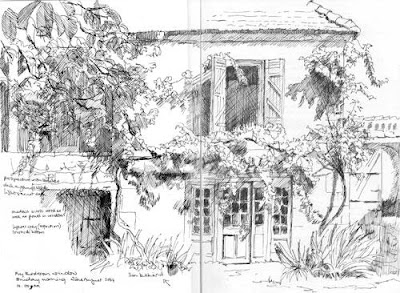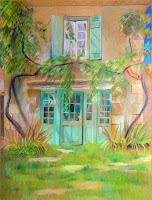copyright Katherine Tyrrell
It's the last day of February and time for a round-up of composition and design posts to date by me and others. I'm really pleased by how this project triggered others into investigating composition - my posts on this topic have been some of the most popular in the 2+ years since I started this blog. I think that shows that there is definite interest in how we can all improve our knowledge and skills in composition.
I'm including in the summary below links to:
- my own posts for the composition and design project - so far! I need to do some more over the course of the year (see also the note at the end)
- links to posts by other people working in the visual arts and crafts fields on their blogs.
- Not all of the links by other people relate to my project - but they are helpful nevertheless! Not all of the links are to recent posts. For those that aren't the aim is to include those that are helpful.
 These are posts which comment across several aspects of composition and design
These are posts which comment across several aspects of composition and design- Katherine Tyrrell (Making A Mark)
- Composition and Design - An Introduction - where I set out what I hoped to do - hopelessly ambitious as usual! (Which means watch out for more later this year!)
- Composition - The Elements of Design - which provides and overview of the different elements of composition and design (Note: This and the next post have proved two of the most popular posts I've ever had on this blog!)
- Composition - Principles of Design - a review of the principles of design - with images as illustrations.
- Vivien Blackburn (Paints, Prints and stuff) - Looking at non traditional composition and quiet vs busy areas in paintings
- Effex Medien (Nubloo's blog) - The 5×5 secret Rules in Design and Advertising - Part 2: Composition This provides a very helpful visual overview of 'the rule of thirds' and the 'rule of odds'
- Katherine Tyrrell (Making A Mark)
- Greg Albert - The Simple Secret to Better Painting - a recommended read.
- Composition and Design - A Digest #1 - summary reviews of a number of books including Composition (Arthur Wesley Dow); Pictorial Composition (Henry Rankin Poore), The Elements of drawing (John Ruskin) and How to Read Paintings
by Nadeije Laneyrie-Dagen. - Rose Welty (Rose's Art Lines) Book Review: Composition is Rose's succinct book review of Arthur Wesley Dow's Composition: Understanding Line, Notan, and Color.
Values
 Katherine Tyrrell (Making A Mark)
Katherine Tyrrell (Making A Mark)- Composition - why tonal values and contrast are important - - value scales, value patterns and what makes them work
- A little notan in the morning - an example of a notan drawing in colour using PS Elements
- Rose Welty (Rose's Art Lines)
- Shaping Your Values - a review of some key ways of organising values on your support
- Valuing Your Values - demonstrates the value of emphasising values
- Robyn (Have Dogs will Travel) Exploring Composition in Pastel - using greyscale
- Lena Levin Values and "posterization test" - developed as a result of my post about Composition - why tonal values and contrast are important
- Robyn (Have Dogs will Travel)
- Composition Exercise Evolves in Acrylic - an exercise using direct painting and a limited palette
- Colour Derived from Notan demonstrates one of the exercises which Robyn followed from the Arthur Wesly Dow book on Composition
- James Gurney (Gurney Journey) Shape Welding focuses on achieving simplicity
The best pictorial compositions are simple. Simple shapes are easy to recognize and remember. Busy pictures with lots of little separate shapes have less impact.Space
James Gurney Gurney Journey Shape Welding
- James Gurney (Gurney Journey) Clustering - which is the name he gives to the method Pyle used so often to arrange a tight group of detail in one interest area, in contrast with large blank areas.
- (MDesign Media Blog) Website Design & Whitespace comments on the use of white space in website design - the equivalent of the empty space in visual artwork.
- Lisa Call (Lisa Call - Contemporary Textile Art): Markings - exploring the concept - an interesting comment from Lisa about how focusing on her composition and the element of lines before she gets into stitching really helps
Nothing specific noted
Principles of design
Finding the crop and the focal point
 Katherine Tyrrell (Making A Mark)
Katherine Tyrrell (Making A Mark) - Composition and Design - finding and creating a focal point
- Composition - the four most important lines - where to crop and how to crop
- Composition - thinking in threes - the golden ratio/rule of thirds, sweet spots and the rule of odds
- Composition - using PS Elements to help with design - for those wanting to know more about how software can help
- Composition - why tonal values and contrast are important - value scales, value patterns and what makes them work
- James Gurney (Gurney Journey) I commend this blog to you all - lots of really excellent advice by the creator of Dinotopia
- Eye Magnets demonstrates eye tracking and comments on theory and values
- Invite / Delight emphasises the importance of inviting the viewer to look and delighting the eye. He provides a lot of really excellent visual examples
- Pyle's Exploratory Thumbnails - how thumbnails were used by a great illustrator
- Four Kinds of Preliminaries - identifies drawings he does during the process of composing an illustration: concept drawing, placement thumbnail, tonal thumbnail, color thumbnail
- Compositional speed dating - extolls the virtues of lots of thumbnail sketching
- Maggie Stiefvater (Greywaren) - Planning & Painting sets the planning and compostional process she uses for her paintings.
- Dan (Empty Easel) - 9 Steps to Creating Better Compositions
- Laurel Neustadter - An Artist's Journey) Maxfield Parrish and Symmetrical Balance
- Rose Welty (Rose's Art Lines) Balance in Composition - the technicals
- Casey Klahn (The Colorist): Composition Posts - Abstract Saturday
- Casey examines how the golden rectangle and golden spiral might apply to one of his abstract works
- John Watson (Photodoto.com) Learning Composition: The Rule of Thirds - this is a recent example by a photographer which suggests how this rule can be used for those wanting to construct a portrait
- Laurel Neustadter (An Artist's Journey) - Maxfield Parrish and the use of pattern
- Maggie Stiefvater (Greywaren) - Artists of the Month: Nielsen & Bauer - looks at how they use pattern in composition
Having said all that I am of course, using an image for this posts which seems to break a number of rules (centred subject matter; daffs just touch the edge of the paper) - did I tell you 'rules' can be broken? I like it - what do you think?
So this is the story so far.
- I still need to review current/modern books which help with composition and will do this soon.
- I'm still thinking over different options for how I can translate my research and my work publications such as 'a checklist for composition'.
- Also, I'm afraid after my big push on composition and design during January and the beginning of February, I rather lacked the stamina to continue to do the research around how to apply compositional design elements and principles to different genres. However I have still this in mind to do this year - just a lot more slowly! I decided in the end that I wanted to avoid having 'rushed' posts so will take my time on this one.
- Please comment below it you have any suggestions or particular recommendations as to any links or useful books which you think should be included around the main genres of:
- figurative
- landscape (but see below for an early contribution from American Artist)
- still life.
- American Artist - Plein Air Pointers: Composition This comprises extracts of text from:
- CARLSON’S GUIDE TO LANDSCAPE PAINTING by John F. Carlson (Dover Publications, Mineola, New York) Excerpt from Chapter 11: Composition—The Expressive Properties of Line and Mass
- COMPOSITION OF OUTDOOR PAINTING by Edgar Payne (DeRu’s Fine Arts, Bellflower, California) Excerpt from Chapter 2: Selection and Composition
- THE ELEMENTS OF DRAWING by John Ruskin (Dover Publications, Mineola, New York)
Excerpt from Chapter 3: On Composition - THE WATSON-GUPTILL HANDBOOK OF LANDSCAPE PAINTING by M. Stephen Doherty (Watson-Guptill Publications, New York, New York) Excerpts from Chapter 3: Planning Your Approach and Chapter 12: Scale and Focus
Note: If you think one of your posts should be included in this summary but that I didn't find it please contact me either by leaving a comment or get the details from here. Note I used Google Blog Search to try and make sure that I didn't miss anybody. You might want to check whether your blog has been found by Google and/or whether you make your topics clear in blog titles or through the use of blog labels or categories - as this is how Google tends to find the posts.














